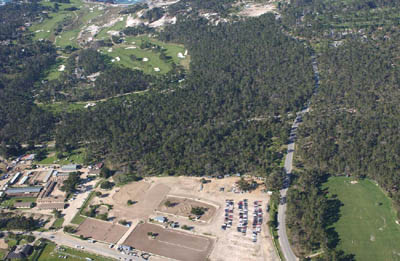Pebble Beach Company to cut down over 17,000
native trees
 |
|
The native Monterey pine forest at Pebble
Beach would be devastated with removal of over 17,000 pines
and native oaks. Additionally, the project would include development
within 100 feet of environmentally sensitive habitat wetlands
and remnant coastal dune structures. Remnant dune structures
can be seen at the top of this photo.
Photo: Ken Adelman
|
The Monterey County Board of Supervisors voted 5-0 to approve extensive
development in Del Monte Forest by the Pebble Beach Company. This
approval came despite written warnings from the Coastal Commission
staff and Chair of the Coastal Commission, Meg Caldwell, a law professor
at Stanford University.
In her letter to the
Board of Supervisors in December, Caldwell had stated that it was
inappropriate for the County to grant final approval for the Pebble
Beach Combined Development Plan application until after the Coastal
Commission reviewed Measure A for conformance with the Coastal Act.
Measure A, which was opposed by the Sierra Club, passed in November
2000. The intent of Measure A was for the Pebble Beach Company to
try to get around some of the environmental restrictions built into
the 1984 Local Coastal Program.
To build this enormous
project, Pebble Beach would cut down over 17,000 rare native Monterey
pine trees and protected oak trees. The proposed 18-hole golf course
and driving range at Spanish Bay would adversely impact some of
the last remaining coastal dunes and wetlands in California. These
areas provide habitat for nineteen species of plants considered
to be rare or endangered under CEQA (California Environmental Quality
Act), seven of which are state or federally-listed including Yadon's
piperia which is only found here. Also severely threatened by this
project is the federally-listed California red-legged frog.
 |
|
Reprinted with permission
from Metro Santa Cruz and Decinzo
|
The plan also includes
33 luxury homes, 160 new hotel rooms, expansion of the Inn at Spanish
Bay, 60 new employee housing units and the relocation of the current
equestrian center to the Sawmill Gulch site. This last component
of the plan would extinguish two scenic easements that were required
as mitigation for the earlier Spanish Bay permit that squeaked by
at the Coastal Commission in 1984. At that time, the new golf course
was touted to be the "last golf course in Pebble Beach."
At the March 15 public
hearing, environmental groups including the Ventana Chapter, California
Native Plant Society (CNPS), Ocean Conservancy and others spoke
passionately against the project citing the decimation of the forest,
plants and wildlife. Corky Matthews of CNPS stressed that the proposal
to transplant trees as mitigation is not realistic. Proponents for
the project included a few residents of Pebble Beach who liked this
plan better than the previous one which proposed building hundreds
of luxury homes.
This earlier project
which was heatedly opposed by residents and environmentalists, may
have been created to make the present proposal seem more reasonable.
Coastal Commission staff stated in their March 14 letter to the
Board of Supervisors that it was misleading for the public to have
been told that up to 900 homes could have been built in the proposed
project area, since only about 41 developable lots have been certified
by the County.
Under the Coastal Act,
the Coastal Commission staff contends, the Local Coastal Plan prohibits
subdivision within Environmentally Sensitive Habitat Area (ESHA).
There is substantial evidence that the undeveloped project lands
are predominately ESHA. Furthermore, recent fieldwork by a Coastal
Commission biologist suggests there is even more significant dune
and wetlands habitat than has been identified by the County to date.
The Chapter and other
groups have appealed this project to the Coastal Commission. At
press time no date had been set for the hearing.
< back to all issues
|

